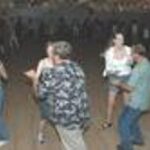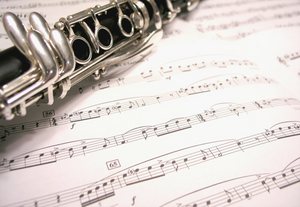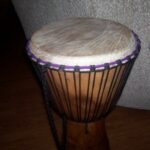A lot of debate still exists in exactly where the late Bo Diddley acquired his famous beat that he used in all of his classic blues (or early rock n’ roll) songs. Some say that the famous beat is based on the clave of Rumba where it’s usually compared to the rhythm of “shave and a haircut.” That makes it sound like it has origins in Vaudeville (or Roger Rabbit, which couldn’t be farther away from Bo Diddley), but is better described as a beat phonetically or an imagined clap of hands: Boom-da-doom-ba-doom, ba-doo-doo. It can get someone confused when counting it out slow. When played at a faster tempo, it’s easy to keep going and arguably one of the most engaging rhythms ever created.
While the arguments are half right about Bo Diddley’s beat origins, most of it comes from an African-American rhythm dance that was basically invented out of necessity. That necessity was the strong need for African-American slaves to express themselves musically when they weren’t allowed to be in possession of drums or other musical instruments.
When you see history through a different perspective, you might say that repression in the vein of slavery created much more effective art for the world. Being repressed to express themselves musically was perhaps one of the worst forms of psychological torture on slaves in early America. Of course, their white slave traders and owners understood that their roots in Africa were immersed in rhythm and playing rhythmical instruments in their home country. What those traders didn’t understand was how resourceful African people were in being able to create rhythm and dance without a single thing. Once everything is taken away from you–using the body is the next best thing.
Slave traders were generally aware that Africans frequently used drums to communicate with one another through specific tap codes (the decorative Yoruba drums in Africa specifically) in order to communicate important messages without speaking. When some slaves used this method to instigate rebellions as slaves in the mid 1800’s, it was the reason why all African slaves were prohibited from being able to play drums. However, they never were taken to task for dancing. That’s when something called the Juba Dance was created that would resemble elements of the clog dance, except it was much more rhythmical and involved patting various parts of the body (i.e. thigh, knees or anywhere else safe to tap out a rhythm on one’s person) to create rhythmical effects. It more or less enabled the first human beatbox.
Actually, West African tribes already had something similar to this dance before being brought to America as slaves. It evolved into something much more artful, though, when they experienced repression here in America when it could be said to be the dancing equivalent to early jazz about fifty years before any sense of that was invented using musical instruments (once slavery was over and African-Americans were allowed to have instruments again). There isn’t any doubt anyway that the Juba Dance is the direct ancestor to modern tap dancing.
Where the Juba Dance got its name and its alternate name…
A lot of conjecture still exists by historians about where the word “Juba” comes from in naming this unique African and American rhythmic dance. There was a King Juba in Numibia of ancient Northern Africa not long before the time of Jesus. A lot of people, though, associated the name from Jubal in the bible who gave us the gift of the very first musical instruments ever made by human beings. Others say that it was just a nickname for the true master of the Juba Dance: William Henry Lane who should have a movie made about his life and amazing dancing exploits.
This free slave who lived in the early to mid 1800’s was a true master at various dances, both European and African. He was also known for being one of the greatest interpreters of the Juba Dance and it’s said that the name came from him when those wowed by his talent called him “Master Juba.” As he traveled around America and competed in dance contests, he invented some of the moves associated with the dance that not many others could do effectively.
A true master of the Juba Dance had to do at least one counter-clockwise turn with one leg raised. If you think that sounds tougher than hell, it was. Doing it so it looked effortless is something that would still be the envy of athletic dancers today, and that quasi-balletic move was a piece of cake for William Henry Lane. Other steps were utilized that had somewhat derogatory names such as the Jubal Jew or Pigeon Wing that were just as challenging to master as the body pats and one-legged turn. The Long Dog Scratch was usually how they ended the dance, followed by random people yelling out “Juba!” and forming a circle to do the same dance moves.
Yes, there was something about it that was also a bit Irish (clog dancing) that makes it all the more American if it indeed was a potpourri of different cultures. It should be noted that Lane was a master of the clog dance, which may have given the dance its slight Irish influence.
The Juba Dance also was called Hambone in tribute to the efficiency of the real hambone that African slaves used to help make soup easier when food was scarce. It was a metaphor for true resourcefulness when expressing yourself through dance was mandatory to stay sane.
____
All of that probably seems far and away from the beats of Bo Diddley. It’s worth noting that Diddley didn’t know anything about the Juba Dance beat and just happened to pick up on it by accident while studying a Gene Autry country arrangement of “I Got Spurs that Jingle Jangle Jingle” in the 1940’s Being off by one beat, Diddley hit on the rhythm associated with Rumba and the Juba Dance.
A lot of this reminds us that musical rhythmic patterns are a bit relational and any specific rhythm we associate with an artist likely has ties to about half-a-dozen different nations.





